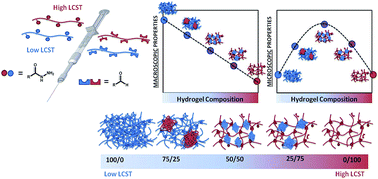“Off-the-shelf” thermoresponsive hydrogel design: tuning hydrogel properties by mixing precursor polymers with different lower-critical solution temperatures†
Abstract
“Off the shelf design” principles are applied to fabricate injectable poly(oligoethylene glycol methacrylate) (POEGMA) hydrogels with well-defined thermal phase transitions by mixing two sets of aldehyde and hydrazide-functionalized hydrogel precursors, one set with a low lower critical solution temperature (LCST) and one set with a high LCST, at different ratios. Macroscopically, gelation rates, swelling kinetics, degradation kinetics, and mechanical properties of hydrogels produced by mixing different precursor polymers can be predicted and designed based on the simple rule of mixtures. Microscopically, phase separated domains result in localized phase transitions within the hydrogels, inducing significant changes in protein affinity, drug release kinetics, transparency, and cell adhesion compared to hydrogels with only single-LCST precursors that may be leveraged in biomedical applications. Such an “off the shelf” design approach involving the simple mixing of a limited number (four) of precursor polymers with different LCSTs can thus achieve a full range of hydrogel properties while avoiding laborious polymerization steps each time a gel with different properties is required.


 Please wait while we load your content...
Please wait while we load your content...